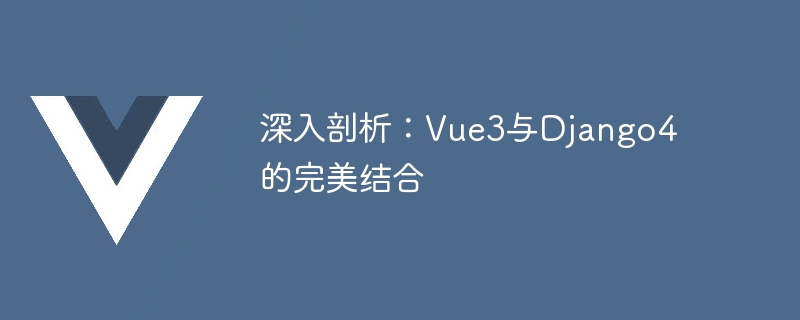Home > Article > Web Front-end > In-depth analysis: the perfect combination of Vue3 and Django4

In-depth analysis: The perfect combination of Vue3 and Django4
With the rise of web applications, front-end and back-end development have increasingly become indispensable in the development team. aspects. In the field of front-end technology, Vue.js 3 has become the framework of choice for many developers, and Django is also popular as a powerful back-end development framework. So, what effects and advantages will the combination of Vue3 and Django4 bring? This article will provide an in-depth analysis of this issue.
First of all, Vue3, as the main force of front-end development, has many exciting new features and improvements. One of the biggest changes is the use of a new responsive system. The reactive system in Vue2 is mainly based on Object.defineProperty, while Vue3 uses Proxy objects to proxy reactive data. This means that data monitoring and updating are more efficient, and it also facilitates the processing of nested data structures.
As a back-end development framework, Django4 also brings a series of new features and improvements. The most important change is support for asynchronous programming. Django 4 introduces asynchronous views and asynchronous request processing capabilities, allowing developers to handle a large number of requests more efficiently. In addition, Django4 also strengthens support for WebSockets, making real-time communication and push easier.
The perfect combination of Vue3 and Django4 can bring many advantages. First of all, both encourage component-based development, making the front-end and back-end code more modular and easier to maintain and expand. Using Vue3's component development method, the page can be divided into independent modules, making front-end development more flexible and simpler. On the backend, Django4's views and models can also be encapsulated as independent components to improve development efficiency.
Secondly, Vue3’s responsive system and Django4’s asynchronous programming capabilities complement each other. In front-end development, Vue3's responsive system can drive data-driven UI changes, so that developers only need to pay attention to data changes without manually manipulating the DOM. In back-end development, Django4's asynchronous programming capabilities can better handle a large number of concurrent requests and improve system performance and response speed.
In addition, both Vue3 and Django4 have strong ecosystems. Vue3 has a rich library of plug-ins and components that can quickly build beautiful user interfaces. Django4 has a huge development community and rich third-party libraries, which can meet various development needs. Combining the two allows for better development of high-quality web applications.
Of course, there are some issues that need to be paid attention to when combining Vue3 and Django4. First of all, it is necessary to reasonably divide the responsibilities of the front and back ends to ensure that the front end is only responsible for the presentation and interaction of the UI, and the back end is responsible for data processing and storage. In addition, good interface design and specification are also needed to ensure smooth communication between the front and back ends. The most important thing is that team members need to have certain front-end and back-end development capabilities to better understand and collaborate.
To sum up, the perfect combination of Vue3 and Django4 can bring many advantages. Both have numerous new features and improvements, making front-end and back-end development more efficient and flexible. Moreover, the responsive system and asynchronous programming capabilities between the two complement each other, improving system performance and user experience. Therefore, combining Vue3 and Django4 can help development teams better build high-quality web applications.
The above is the detailed content of In-depth analysis: the perfect combination of Vue3 and Django4. For more information, please follow other related articles on the PHP Chinese website!